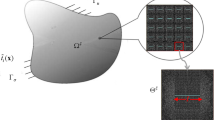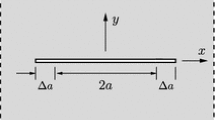Abstract
The existence of crack and notch is a considerable and serious subject in the failure study of solids and structures. As most of cracked domain problems do not have closed-form solutions, numerical methods are dominant approaches dealing with fracture mechanics problems. In fracture mechanics and failure analysis, cracked media energy and consequently stress intensity factors (SIFs) play a crucial and significant role. Based on linear elastic fracture mechanics, the SIFs may be estimated using the energy release rate, as an indirect approach. This study presents the development of a new semi-analytical method to model cracked media. In this method, only the boundaries of problems are discretized using specific higher-order subparametric elements and higher-order Chebyshev mapping functions. Implementing the weighted residual method and using Clenshaw–Curtis quadrature yield diagonal Euler’s differential equations. Therefore, when the local coordinate origin is located at the crack tip, the geometry of crack problems is implemented directly without further processing. In order to present crack boundary conditions, a modified form of nodal force function is presented. Validity and accuracy of the proposed method is fully illustrated by four benchmark problems, whose results agree very well with those of other numerical and/or analytical solutions existing in the literature.
Similar content being viewed by others
References
Williams, M.L.: On the stress distribution at the base of a stationary crack. J. Appl. Mech. 24, 109–114 (1957)
Anderson, T.L.: Fracture Mechanics: Fundamentals and Applications. Taylor & Francis, Routledge (2005)
Mayrhofer, K.: Closed-form solutions for finite-part integrals occurring in shear-mode fracture mechanics. Acta Mech. 105, 85–100 (1994)
Henshell, R.D., Shaw, K.G.: Crack tip finite elements are unnecessary. Int. J. Numer. Meth. Eng. 9, 495–507 (1975)
Barsoum, R.S.: On the use of isoparametric finite elements in linear fracture mechanics. Int. J. Numer. Meth. Eng. 10, 25–37 (1976)
Souiyah, M., Alshoaibi, A., Muchtar, A., Ariffin, A.K.: Two-dimensional finite element method for stress intensity factor using adaptive mesh strategy. Acta Mech. 204, 99–108 (2009)
Liu, P., Bui, T.Q., Zhang, C., Yu, T.T., Liu, G.R., Golub, M.V.: The singular edge-based smoothed finite element method for stationary dynamic crack problems in 2D elastic solids. Comput. Methods Appl. Mech. Eng. 233–236, 68–80 (2012)
Kang, Z., Bui, T.Q., Nguyen, D.D., Saitoh, T., Hirose, S.: An extended consecutive-interpolation quadrilateral element (XCQ4) applied to linear elastic fracture mechanics. Acta Mech. 226, 3991–4015 (2015)
Laborde, P., Pommier, J., Renard, Y., Salaün, M.: High-order extended finite element method for cracked domains. Int. J. Numer. Meth. Eng. 64, 354–381 (2005)
Mohammadi, S.: Extended Finite Element Method: For Fracture Analysis of Structures. Wiley, Chichester (2008)
Bui, T.Q., Zhang, C.: Extended finite element simulation of stationary dynamic cracks in piezoelectric solids under impact loading. Comput. Mater. Sci. 62, 243–257 (2012)
Bui, T.Q., Zhang, C.: Analysis of generalized dynamic intensity factors of cracked magnetoelectroelastic solids by X-FEM. Finite Elem. Anal. Des. 69, 19–36 (2013)
Liu, P., Yu, T., Bui, T.Q., Zhang, C.: Transient dynamic crack analysis in non-homogeneous functionally graded piezoelectric materials by the X-FEM. Comput. Mater. Sci. 69, 542–558 (2013)
Sharma, K., Bui, T.Q., Zhang, C., Bhargava, R.R.: Analysis of a subinterface crack in piezoelectric bimaterials with the extended finite element method. Eng. Fract. Mech. 104, 114–139 (2013)
Cruse, T.A., Vanburen, W.: Three-dimensional elastic stress analysis of a fracture specimen with an edge crack. Int. J. Fract. Mech. 7, 1–15 (1971)
Portela, A., Aliabadi, M.H., Rooke, D.P.: Efficient boundary element analysis of sharp notched plates. Int. J. Numer. Methods Eng. 32, 445–470 (1991)
Chen, C.-S., Ke, C.-C., Tu, C.-H.: Evaluating the stress intensity factors of anisotropic bimaterials using boundary element method. Int. J. Numer. Anal. Methods Geomech. 32, 1341–1364 (2008)
Treifi, M., Oyadiji, S.O.: Strain energy approach to compute stress intensity factors for isotropic homogeneous and bi-material V-notches. Int. J. Solids Struct. 50, 2196–2212 (2013)
Larrosa, N.O., Treifi, M., Ainsworth, R.A.: Rapid parametric analysis of SEN(T) specimens using algorithmic modelling: evaluation of strain energy density and notch stress intensity factors. Mater. Des. 85, 771–777 (2015)
Belytschko, T., Gu, L., Lu, Y.Y.: Fracture and crack growth by element free Galerkin methods. Model. Simul. Mater. Sci. Eng. 2, 519–534 (1994)
Menouillard, T., Belytschko, T.: Dynamic fracture with meshfree enriched XFEM. Acta Mech. 213, 53–69 (2010)
Gu, Y.T., Zhang, L.C.: Coupling of the meshfree and finite element methods for determination of the crack tip fields. Eng. Fract. Mech. 75, 986–1004 (2008)
Nguyen, N.T., Bui, T.Q., Zhang, C., Truong, T.T.: Crack growth modeling in elastic solids by the extended meshfree Galerkin radial point interpolation method. Eng. Anal. Bound. Elem. 44, 87–97 (2014)
Tanaka, S., Suzuki, H., Sadamoto, S., Imachi, M., Bui, T.Q.: Analysis of cracked shear deformable plates by an effective meshfree plate formulation. Eng. Fract. Mech. 144, 142–157 (2015)
Leung, A.Y.T., Wong, S.C.: Two-level finite element method for plane cracks. Commun. Appl. Numer. Methods 5, 263–274 (1989)
Leung, A.Y.T., Su, R.K.L.: Mode I crack problems by fractal two level finite element methods. Eng. Fract. Mech. 48, 847–856 (1994)
Song, C., Wolf, J.P.: Semi-analytical representation of stress singularities as occurring in cracks in anisotropic multi-materials with the scaled boundary finite-element method. Comput. Struct. 80, 183–197 (2002)
Chowdhury, M.S., Song, C., Gao, W.: Probabilistic fracture mechanics by using Monte Carlo simulation and the scaled boundary finite element method. Eng. Fract. Mech. 78, 2369–2389 (2011)
Tanaka, S., Suzuki, H., Ueda, S., Sannomaru, S.: An extended wavelet Galerkin method with a high-order B-spline for 2D crack problems. Acta Mech. 226, 2159–2175 (2015)
Ooi, E.T., Yang, Z.J.: A hybrid finite element-scaled boundary finite element method for crack propagation modelling. Comput. Methods Appl. Mech. Eng. 199, 1178–1187 (2010)
Bird, G.E., Trevelyan, J., Augarde, C.E.: A coupled BEM/scaled boundary FEM formulation for accurate computations in linear elastic fracture mechanics. Eng. Anal. Bound. Elem. 34, 599–610 (2010)
Khaji, N., Khodakarami, M.I.: A new semi-analytical method with diagonal coefficient matrices for potential problems. Eng. Anal. Bound. Elem. 35, 845–854 (2011)
Khodakarami, M.I., Khaji, N.: Analysis of elastostatic problems using a semi-analytical method with diagonal coefficient matrices. Eng. Anal. Bound. Elem. 35, 1288–1296 (2011)
Khaji, N., Khodakarami, M.I.: A semi-analytical method with a system of decoupled ordinary differential equations for three-dimensional elastostatic problems. Int. J. Solids Struct. 49, 2528–2546 (2012)
Khodakarami, M.I., Khaji, N., Ahmadi, M.T.: Modeling transient elastodynamic problems using a novel semi-analytical method yielding decoupled partial differential equations. Comput. Methods Appl. Mech. Eng. 213–216, 183–195 (2012)
Khaji, N., Mirzajani, M.: Frequency domain analysis of elastic bounded domains using a new semi-analytical method. Acta Mech. 224, 1555–1570 (2013)
Khodakarami, M.I., Khaji, N.: Wave propagation in semi-infinite media with topographical irregularities using Decoupled Equations Method. Soil Dyn. Earthq. Eng. 65, 102–112 (2014)
Moghadaszadeh, S.O., Khaji, N.: Development and application of a semi-analytical method with diagonal coefficient matrices for analysis of wave diffraction around vertical cylinders of arbitrary cross-sections. Ocean Eng. 110, 292–302 (2015)
Hibbeler, R.C.: Structural Analysis. Pearson Prentice Hall, Upper Saddle River (2012)
Colombo, C., Guagliano, M., Vergani, L.: A numerical analysis of flat internal cracks under mixed mode loading. Theor. Appl. Fract. Mech. 50, 66–73 (2008)
DeLorenzi, H.G.: On the energy release rate and the J-integral for 3-D crack configurations. Int. J. Fract. 19, 183–193 (1982)
He, Q.L., Wu, L., Li, M., Yu, H.: Prediction of mode i crack growth resistance based on a comparative investigation of J-integral and energy dissipation rate concept. Acta Mech. 215, 175–191 (2010)
Maugin, G.A.: On the J-integral and energy-release rates in dynamical fracture. Acta Mech. 105, 33–47 (1994)
Fischer, F.D., Rammerstorfer, F.G.: Mode-I crack projection procedure using the strain energy density criterion. Theor. Appl. Fract. Mech. 20, 67–74 (1994)
Okada, H., Kawai, H., Araki, K.: A virtual crack closure-integral method (VCCM) to compute the energy release rates and stress intensity factors based on quadratic tetrahedral finite elements. Eng. Fract. Mech. 75, 4466–4485 (2008)
Radaj, D.: State-of-the-art review on the local strain energy density concept and its relation to the J-integral and peak stress method. Fatigue Fract. Eng. Mater. Struct. 38, 2–28 (2015)
Rossmanith, H.P.: Analysis of mixed-mode isochromatic crack-tip fringe patterns. Acta Mech. 34, 1–38 (1979)
Yuan, H.: Dynamic crack growth along an elastoplastic bimaterial interface. Acta Mech. 121, 51–77 (1997)
Bui, T.Q.: Extended isogeometric dynamic and static fracture analysis for cracks in piezoelectric materials using NURBS. Comput. Methods Appl. Mech. Eng. 295, 470–509 (2015)
Tada, H., Paris, P.C., Irwin, G.R.: The Stress Analysis of Cracks Handbook. Professional Engineering Publishing, Missouri (1985)
Xiao, Q.Z., Karihaloo, B.L., Liu, X.Y.: Direct determination of SIF and higher order terms of mixed mode cracks by a hybrid crack element. Int. J. Fract. 125, 207–225 (2004)
Rao, B.N., Rahman, S.: Probabilistic fracture mechanics by Galerkin meshless methods—part I: rates of stress intensity factors. Comput. Mech. 28, 351–364 (2002)
Hellen, T.K., Blackburn, W.S.: The calculation of stress intensity factors for combined tensile and shear loading. Int. J. Fract. 11, 605–617 (1975)
Author information
Authors and Affiliations
Corresponding author
Rights and permissions
About this article
Cite this article
Yazdani, M., Khaji, N. & Khodakarami, M.I. Development of a new semi-analytical method in fracture mechanics problems based on the energy release rate. Acta Mech 227, 3529–3547 (2016). https://doi.org/10.1007/s00707-016-1685-3
Received:
Revised:
Published:
Issue Date:
DOI: https://doi.org/10.1007/s00707-016-1685-3




